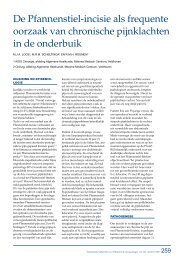Surgical management of chronic inguinal pain syndromes - Liespijn
Surgical management of chronic inguinal pain syndromes - Liespijn
Surgical management of chronic inguinal pain syndromes - Liespijn
You also want an ePaper? Increase the reach of your titles
YUMPU automatically turns print PDFs into web optimized ePapers that Google loves.
VAS*Values no <strong>pain</strong> mild moderate severe Kappa 1Cut-<strong>of</strong>f points (mm) 0-8 9-32 33-71 >71(n=388) (n=143) (n=61) (n=11)VRS*No <strong>pain</strong> (n=391) 372 17 2 0 0.78Mild (n=141) 13 113 14 1Moderate (n=62) 3 13 43 3Severe (n=9) 0 0 2 7Table 4a Optimal VAS cut-<strong>of</strong>f points in patients with groin hernia repair who completed the questionnaire (n=603).*VAS = Visual Analogue Scale (mm), VRS = Verbal Rating Scale, 1 Kappa coefficient.VAS*Values no <strong>pain</strong> mild moderate severe Kappa 1Cut-<strong>of</strong>f points (mm) 0 1-9 10-50 >50(n=341) (n=51) (n=179) (n=32)VRS*No <strong>pain</strong> (n=391) 341 34 15 1 0.43Mild (n=141) 0 14 125 2Moderate (n=62) 0 3 39 20Severe (n=9) 0 0 0 9Table 4b VAS cut-<strong>of</strong>f points as used in groin <strong>pain</strong> literature [5] (n=603).*VAS = Visual Analogue Scale (mm), VRS = Verbal Rating Scale, 1 Kappa coefficient.DISCUSSIONSeveral tools for <strong>pain</strong> measurement including a Visual Analogue Scale (VAS) and aVerbal Rating Scale (VRS) are currently used in patients with <strong>chronic</strong> <strong>pain</strong>. Ideally a toolis simple, sensitive and reproducible. In the present study determining intensity <strong>of</strong> postherniorrhaphy<strong>pain</strong>, both tests have been examined for simplicity by assessing theirfailure rate. The VAS failure rate appeared to be significantly higher compared to theVRS. This may have been affected by the order in which the scales were presented, sincethe highest VAS non-compliance rate was in the VRS ‘no <strong>pain</strong>’ group. However, comparablescale failure rates ranging from 10.0 to 14.1% (VAS) and 0.0 to 0.5 % (VRS) havebeen reported in the literature 3,4 . Our study identified advanced age as a risk factor forVAS scale failure. In a previous <strong>pain</strong> study evaluating various <strong>pain</strong> rating scales, mentaland motor impairment were also identified as relative risk factors associated with scalefailure 4 . The lowest scale failure in postherniorrhaphy groin <strong>pain</strong> patients can thus beattained using a VRS.Apart from a mandatory simplicity, any <strong>pain</strong> test must also possess a high sensitivity.VAS tests are inherently associated with a higher sensitivity when compared to a VRS.However, in cross-sectional <strong>pain</strong> assessment studies this advantage also poses analyticaldifficulties. Application <strong>of</strong> cut-<strong>of</strong>f points is mandatory in order to convert VAS intoVRS scores. VAS cut-<strong>of</strong>f points were introduced at an arbitrary level in one postherniorrhaphygroin <strong>pain</strong> study 5 . After application <strong>of</strong> both VAS and VRS tests on a comparablecohort <strong>of</strong> postherniorrhaphy groin <strong>pain</strong> patients, the present study revealed totallydifferent cut-<strong>of</strong>f points with higher kappa values. Moreover, our results agreed withother <strong>pain</strong> studies assessing patients with a stroke, laparotomy or knee surgery (0 mm= no <strong>pain</strong>, 70 mm = severe <strong>pain</strong>) 19-22 . Thus,with employment <strong>of</strong> the present cut-<strong>of</strong>f points, the best possible interpretation <strong>of</strong> VASscores can be obtained.Which factors determine level <strong>of</strong> VAS cut-<strong>of</strong>f points? The present study did not reveal anyage or sex-related VAS scale variation in concert with others 20,22 . However, cut-<strong>of</strong>f pointsare known to be influenced by <strong>pain</strong> experience and etiology. A study among 80 patientsrecovering from spinal cord injury demonstrated that <strong>chronic</strong> <strong>pain</strong> <strong>of</strong> neuropathicetiology is associated with higher cut-<strong>of</strong>f points compared to nociceptive <strong>pain</strong> 22 . Patientswith postherniorrhaphy <strong>pain</strong> frequently suffer from neuropathic <strong>pain</strong> concurring withthe need for upgrading cut-<strong>of</strong>f points 23 .There are considerable inter-individual differences in the way patients grade their <strong>pain</strong>intensity on a VAS. Wide ranges with outliers and extreme cases in the ‘no <strong>pain</strong>, mild andmoderate <strong>pain</strong>’ categories resulted in a considerable overlap. For example, three caseswith each different VRS scores (mild, moderate and severe) marked their VAS at 52 mm.For these individuals identical VAS scores represented entirely different <strong>pain</strong> intensities.In accordance with a previous study this suggests that VAS scores are not interchangeablewith VRS results 22 . To simplify the matter, Collins et al. tried to investigatewhat moderate <strong>pain</strong> is in millimetres on the VAS. 1080 cases (with both VAS and 4-pointVRS scores) were taken from eleven randomized controlled trails investigating theanalgesic effects <strong>of</strong> various drugs on postoperative <strong>pain</strong> 20 . They suggested grading anestimate <strong>of</strong> >30 mm on a VAS as moderate or severe <strong>pain</strong> since 85% <strong>of</strong> all patients whoreported moderate <strong>pain</strong> and 98% <strong>of</strong> those who reported severe <strong>pain</strong> on a 4-point VRSwould be included. However, this statement also implies acceptance <strong>of</strong> over- andunderestimation <strong>of</strong> <strong>pain</strong> intensity as well, which is certainly not desirable in clinicalpractice. Therefore, VAS data should not be labelled with VRS categories for individual<strong>pain</strong> assessment.Reproducibility is another quality a test should exhibit. Unfortunately, the present study58 Chapter 4Evaluating postherniorrhaphy groin <strong>pain</strong>: Visual Analogue or Verbal Rating Scale? 59





